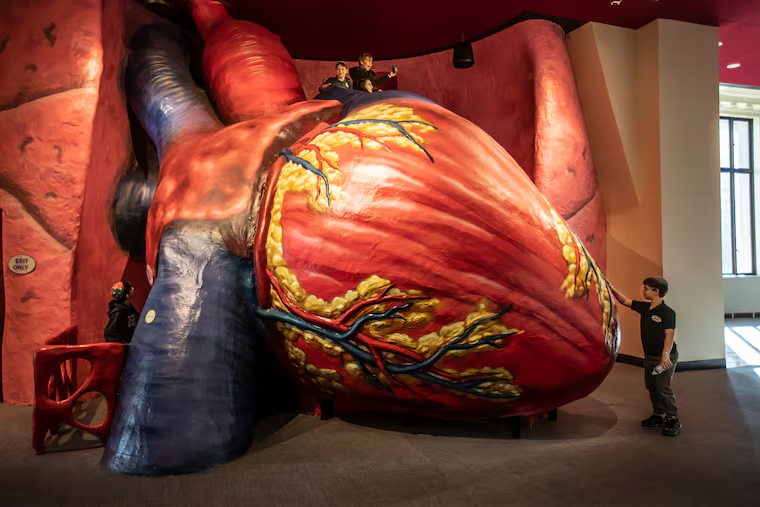The Franklin Institute’s Giant Heart is closing for six months
The museum is pumping up the 70-year-old heart to become the centerpiece of a new exhibit.

The Franklin Institute’s “Giant Heart” — a beloved exhibit at the Philadelphia science museum for 70 years — is closing to the public May 6.
But don’t worry, this sudden cardiac arrest is not in vein. The Giant Heart will reopen in November as the centerpiece of a new, permanent exhibit about the human body, the name of which is yet to be unveiled.
The Franklin is also closing its “Electricity” exhibit permanently on May 6 to make space for the human body exhibit.
The Giant Heart, which debuted in 1954, was a labor of love for physician Mildred Pfeiffer, who worked with a medical illustrator and engineer to design the 28-foot-wide and 18-foot-high heart out of wood, papier-mâché, and chicken wire.
For generations, walking through this tremendous ticker has been a rite of passage for schoolchildren on trips to the museum. Some people never forget the thumping sound within, kissing their first crush inside of its walls, or the distinctive smell, descriptions of which have ranged from “general funk” to “belly button.”
The Giant Heart is such a fixture in the city and in the real hearts of Philadelphians that it even made a cameo in Abbott Elementary last season when the school went on an overnight field trip to the Franklin Institute.
The heart was refurbished and rebuilt with fiberglass in 1979 and has undergone several upgrades since, the most recent of which was in 2020. The previously computer-generated noise of a beating heart was replaced with the real sounds of a human heart, and the exhibit got new lighting and a new paint job. The flooring was also replaced, which removed the distinctive smell so many recalled.
Conservation work will once again be done on the heart while it’s off view to the public, but it will remain in its current location during the exhibit transformation, said Franklin Institute spokesperson Stefanie Santo. The museum’s live dissections, which are held just outside of the heart, will resume at another location in the museum on May 11.
The new exhibit on the human body that the Giant Heart will be the centerpiece of is one of six new, permanent exhibits that are planned to replace 12 existing ones. The first, “Wondrous Space,” debuted last year, and other forthcoming exhibits include those on computer science, the built environment, earth systems, and advanced machines and robotics.
Another beloved treasure of the museum, its Baldwin 60,000 steam locomotive, will be the centerpiece of the new Hamilton Collections Gallery, which is also slated to open in November in the space that formerly housed the “Train Factory.” The gallery will feature a rotating display of artifacts from the museum’s collection.
The new exhibits will serve as the capstone to the Franklin’s 200th anniversary this year, Santo said.